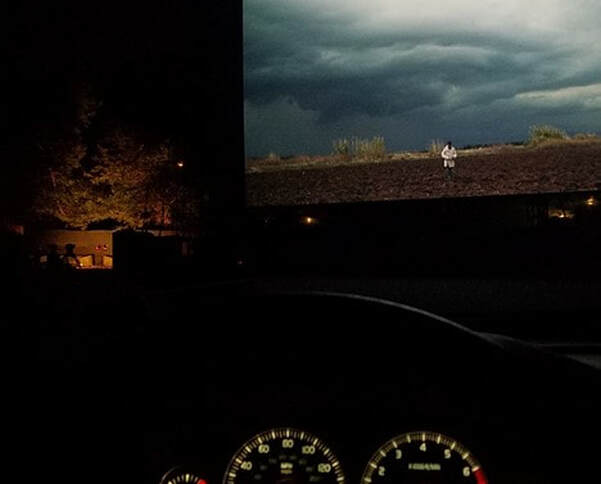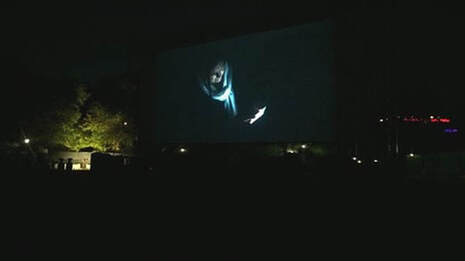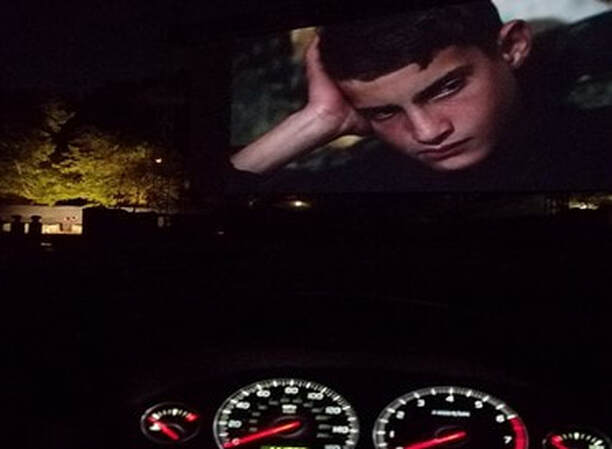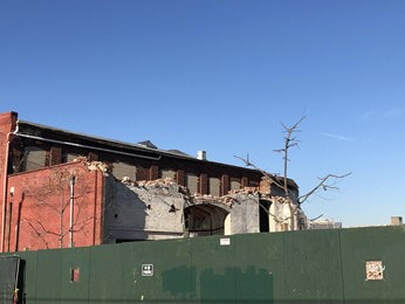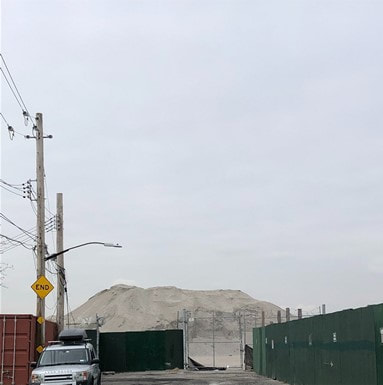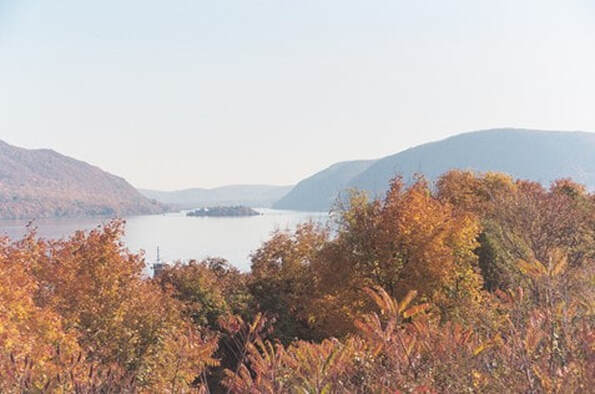The Feeling of Lineage
On place-based poetics
Emily Conklin
|
How can we remember so clearly a couch merely by the way we saw a person lying on it? Is memory inherent in the objects themselves, or the place in which we find them? Where do body and designed form intersect, or moreover, where do they become one?
|
In Newburgh and Red Hook, NY, there are “front ends” and “back ends;” areas defined by the majority of residents landing in one of two demographics: affluent white newcomers or historically blue collar Black and brown residents. If you reserve a weekend to take your fixie bike to Red Hook or the Metro North up to Newburgh, maybe to a well-reviewed restaurant or waterfront park, you see the front end. There, you buy your natural wine from a glass-fronted store with a record player in the back. But if you’re a blue collar worker who’s called the neighborhood home since before the warehouses were emptied to create the natural wine bars, you buy your spirits in the back end, ringing a buzzer and waiting for the cashier to spin your bottle through the dusty plastic carousel.
I found both Newburgh and Red Hook by accident, despite the destinations lying over 50 miles apart. I was following my nose to find a connection to the water (It’s sometimes easy to forget that New York City is entirely surrounded by this element.) I did ride in on my fixie bicycle, and did take the Metro North, gazing out the left hand window and marveling at how close the Hudson Line trains get to the rocky edge of the river. But I also met the unnerving gaze of an old cashier behind bulletproof glass. He looked at me, puzzled, when I asked for a bottle of sparkling wine. “Are you lost?” he asked. I was living around the block. I laughed with him for a few minutes and watched him light a cigarette with a steady, studied ease. I tapped on the glass to accompany my goodbye and he tapped back.
I found both Newburgh and Red Hook by accident, despite the destinations lying over 50 miles apart. I was following my nose to find a connection to the water (It’s sometimes easy to forget that New York City is entirely surrounded by this element.) I did ride in on my fixie bicycle, and did take the Metro North, gazing out the left hand window and marveling at how close the Hudson Line trains get to the rocky edge of the river. But I also met the unnerving gaze of an old cashier behind bulletproof glass. He looked at me, puzzled, when I asked for a bottle of sparkling wine. “Are you lost?” he asked. I was living around the block. I laughed with him for a few minutes and watched him light a cigarette with a steady, studied ease. I tapped on the glass to accompany my goodbye and he tapped back.
That moment was a threshold just as tangible as cycling beneath the Gowanus Expressway, or fording the Hudson via the Newburgh Bridge. I felt a tangible change of place, a conversion of new and old. These sister neighborhoods of Red Hook and Newburgh are set apart, as the people, buildings, and cultures have evolved at an organic pace: these are not the products of master plans. The authenticity is palpable because encounters are made by accident in a world where we are losing our sense of that serendipity. I followed my nose to Red Hook and Newburgh and countless other “spots” (I’m sure you have your own, too) as if I was following a hum, looking for the source of its sound. I wanted to sit, and sit deeply, and come back the next day to learn and see more of these neighborhoods like icebergs: so much is hidden below the initial veneer.
These moments of connection, and of crossing boundaries, are the fuel behind my ongoing research into historic architectural preservation and the poetics of place. As a student of architecture history at NYU, I completed an honors thesis on the industrial heritage of Red Hook and the forces shaping its post-industrial reality. I met my essay’s characters — the buildings — by peering through windows and opening doors. But I got to know them through the ritual of return; rewalking the streets, and never ceasing to find something new or changing. Sitting with my deli sandwiches or Lipton teas by the riverfront, I would always bring a journal where I’d jot thoughts or make quick sketches of buildings that caught my attention. I asked questions like “Why do I like it here so much?” “Does being here as a privileged white woman make me a gentrifier?” “Why do the ‘ends’ exist and who’s upholding them?” I also crafted some of the verses included in this essay, poetry feeling like the closest form to true translation. But above all I walked the city blocks, the same ones and new, over the course of two years. I’m still walking them. That’s the only way to know a place, just like it’s the only way to know a person. It’s a way of uncovering common lineage.
These moments of connection, and of crossing boundaries, are the fuel behind my ongoing research into historic architectural preservation and the poetics of place. As a student of architecture history at NYU, I completed an honors thesis on the industrial heritage of Red Hook and the forces shaping its post-industrial reality. I met my essay’s characters — the buildings — by peering through windows and opening doors. But I got to know them through the ritual of return; rewalking the streets, and never ceasing to find something new or changing. Sitting with my deli sandwiches or Lipton teas by the riverfront, I would always bring a journal where I’d jot thoughts or make quick sketches of buildings that caught my attention. I asked questions like “Why do I like it here so much?” “Does being here as a privileged white woman make me a gentrifier?” “Why do the ‘ends’ exist and who’s upholding them?” I also crafted some of the verses included in this essay, poetry feeling like the closest form to true translation. But above all I walked the city blocks, the same ones and new, over the course of two years. I’m still walking them. That’s the only way to know a place, just like it’s the only way to know a person. It’s a way of uncovering common lineage.
“The act of walking is to the urban system what the speech act is to language.” — Michel de Certeau
In her poetry collection Something Bright, Then Holes, Maggie Nelson uses verse to record intimate visits to the infamous industrial waste conduit in South Brooklyn called the Gowanus Canal, and the interactions with thoughts, people and animals that occurred on its banks. It’s a slim tome, but one that weaves together the power of being-in a place repeatedly, even when you don’t really want to be. This form of place-based discipline can shape or reveal the self. Take the verse from Nelson’s Evensong:
Giving up? the man asks
when I close my book
Yes, the light is fading
I know I could read your poems
in the dark, but I am allowed only one
a day, and even that’s
too much.
when I close my book
Yes, the light is fading
I know I could read your poems
in the dark, but I am allowed only one
a day, and even that’s
too much.
There’s a site-specific poetry within industrial communities and their watery borders. Evensong illuminates a way that Nelson, as an observer of place, hears the humming of her chosen Gowanus canal, and how she attempts to translate it. In a way, the humming is probably why she found herself returning to the canal at all, long before she chose it as a subject of serious study. She may appear to be reading to a casual passerby, but really, her open book, her position as a sitter on the wharf, and her being-in the coming twilight — all of it is the poem. The canal is the “your,” the writer of it all, and the stage on which the poem plays out. A day at the canal’s edge.
The Industrial Revolution changed our consumer culture as we knew it between roughly 1850-1950, and acted as the impetus for Nelson’s cargo-carrying canal, and as a parallel, my chosen warehouses that stored what floated down. The heavy timber and red brick buildings have stood sentinel at the same intersections on the same bricks for over 100 years, a novelty in a contemporary society where new architecture has a lifespan of roughly 40. But most profoundly, I noticed in myself and in others I walked the streets with, that these disappearing “old buildings” are a tantalizing tourist attraction for a generation that feeds on nostalgia, from vinyl records to vintage Levi’s. The buildings here have remained, it’s just the people and things within that have changed.
These pockets of preserved vernacular architectural legacy hum at a lower frequency than the curtain walls of Manhattan’s tourist corridors. This feeling is palpable in the same way as that of a quiet art gallery, or a narrow side street. We’re used to celebrating “great” buildings like the Pantheon or the Chrysler Building, but vernacular architecture — defined as a type of local or regional construction, using traditional materials and resources — is one of the most accessible ways we can gain insight into the socioeconomic context of a culture. To many preservationists, historians, activists and artists, it is a way of asserting identity. However, it’s also contributed to an emerging cultural tourism, as people much like myself flock to spaces where they can see themselves, where they can identify. There, place hums at a much deeper frequency than much of our new urbanism and architecture, characterized by superhuman size and anonymity.
Developers are catching onto this attraction, though, and flipping it on its head. By taking the veneer of an era or the trappings of an identity, you cannot fill in the gaps where years and lineage has made it complete. You cannot capture the hum, or determine where it’s heard. Think about how brokers list “exposed brick” in the amenities section on StreetEasy listings: Today, we are paying top dollar for a nostalgic aesthetic, an “industrial chic” that dovetails tantalizingly well with our general aptitude for minimalism in home decor, and the ephemeral character of rental culture. Yet only a few decades ago, these details we today find trendy were once truly emblematic of utilitarianism, and defined the workplaces and homes of American’s blue collar classes on the front lines of industrial output.
So how did we get here? How did we as a society make the leap from taste meaning Gilded Age gold leaf and enfiladed beaux-arts mansions? Now, we are falsely aging our shiny materials to match the optics of abandoned architecture, and its history of facilitating exploitative immigrant labor. Herein lies not only the crux of my inquiry, but the fuel for my research into the oft-overlooked preservation of historic industrial architecture.
The Industrial Revolution changed our consumer culture as we knew it between roughly 1850-1950, and acted as the impetus for Nelson’s cargo-carrying canal, and as a parallel, my chosen warehouses that stored what floated down. The heavy timber and red brick buildings have stood sentinel at the same intersections on the same bricks for over 100 years, a novelty in a contemporary society where new architecture has a lifespan of roughly 40. But most profoundly, I noticed in myself and in others I walked the streets with, that these disappearing “old buildings” are a tantalizing tourist attraction for a generation that feeds on nostalgia, from vinyl records to vintage Levi’s. The buildings here have remained, it’s just the people and things within that have changed.
These pockets of preserved vernacular architectural legacy hum at a lower frequency than the curtain walls of Manhattan’s tourist corridors. This feeling is palpable in the same way as that of a quiet art gallery, or a narrow side street. We’re used to celebrating “great” buildings like the Pantheon or the Chrysler Building, but vernacular architecture — defined as a type of local or regional construction, using traditional materials and resources — is one of the most accessible ways we can gain insight into the socioeconomic context of a culture. To many preservationists, historians, activists and artists, it is a way of asserting identity. However, it’s also contributed to an emerging cultural tourism, as people much like myself flock to spaces where they can see themselves, where they can identify. There, place hums at a much deeper frequency than much of our new urbanism and architecture, characterized by superhuman size and anonymity.
Developers are catching onto this attraction, though, and flipping it on its head. By taking the veneer of an era or the trappings of an identity, you cannot fill in the gaps where years and lineage has made it complete. You cannot capture the hum, or determine where it’s heard. Think about how brokers list “exposed brick” in the amenities section on StreetEasy listings: Today, we are paying top dollar for a nostalgic aesthetic, an “industrial chic” that dovetails tantalizingly well with our general aptitude for minimalism in home decor, and the ephemeral character of rental culture. Yet only a few decades ago, these details we today find trendy were once truly emblematic of utilitarianism, and defined the workplaces and homes of American’s blue collar classes on the front lines of industrial output.
So how did we get here? How did we as a society make the leap from taste meaning Gilded Age gold leaf and enfiladed beaux-arts mansions? Now, we are falsely aging our shiny materials to match the optics of abandoned architecture, and its history of facilitating exploitative immigrant labor. Herein lies not only the crux of my inquiry, but the fuel for my research into the oft-overlooked preservation of historic industrial architecture.
One of the first cultural experiences I had as a newcomer to New York was a mandated visit to the Tenement Museum, an excursion with a seminar class. The trip was scheduled for 8am. I’m certainly not a morning person, and moreover, I was uninitiated to the idiosyncrasies of the city, disgruntled by the delayed subways and oppressive August heat. Yet, no event singularly informed the way I now inhabit New York City. The museum is simply a preserved tenement on the Lower East Side with a history traced back to a German immigrant family who ran a beer hall on the ground floor. The building is six storeys high, and no different on the exterior as the continuously inhabited buildings beside it. On this particular August day, though, the apartment we toured — on the sixth floor — offered no air conditioned reprieve. The only ventilation of any sort came in through two windows at either end of the railroad-style space that necessitated walking through what we now consider “private” spaces like bedrooms and bathrooms just to get to the kitchen or common area. What struck me wasn’t the humid discomfort though, but the docent’s records of how many family members crammed into these seemingly inhabitable spaces, with no door to close to keep the world out.
Just a few blocks away on Thompson Street, I rented an apartment that fit the exact footprint of the Museum’s, but it was home to just myself and one other, not a family of 6 or 8. I thought of my own feelings of being stifled within my one-windowed room, in my twin sized bed, but reflected on how it was a room of my own nonetheless, with a door that locked. The tour sparked a deep internal investigation of my own lived experience in Lower Manhattan, and how I was unknowingly just another tick on the timeline of this vernacular architectural lineage, immersed in the still breathing spaces of the past.
Just a few blocks away on Thompson Street, I rented an apartment that fit the exact footprint of the Museum’s, but it was home to just myself and one other, not a family of 6 or 8. I thought of my own feelings of being stifled within my one-windowed room, in my twin sized bed, but reflected on how it was a room of my own nonetheless, with a door that locked. The tour sparked a deep internal investigation of my own lived experience in Lower Manhattan, and how I was unknowingly just another tick on the timeline of this vernacular architectural lineage, immersed in the still breathing spaces of the past.
|
It’s Thursday so I wake up dehydrated and thinking of the ridges of collarbones. But without the bitemarks my bedroom is overcooked in blue and I depart without a shower.
There is an Italian cucina on my street the size of a spoon and open to the grime-speckled New York air. Lunch is $10 and I can scrape my eyes against the still sooty tenements of SoHo that glow in their wisdom. I’ve ordered the spaghetti with clams. I hate blue pens. Everyone is speaking Italian at a clipped pace. |
Unknowingly, thousands of New Yorkers inhabit these same brick envelopes, home to not just residences but the streetside cafes that make the city streets sing as they do downtown. They were speculatively built by all manner of investors in the boom years of the industrial revolution, often expressly for workers at the docks and in factories. Filled with layers and layers of wallpaper, stories, and the soot of fires and stoves where we now have retrofitted central air or window A/C units, these buildings that today’s young renters inhabit are merely freshly painted antique white and fitted with new appliances. The walls are the same, and the stories held within are just as palpable if you care to peel back the layers.
Old buildings continue their legacy as homes for a myriad of newcomers and immigrants, artists and service workers. Therefore, they are infinitely more important to the diversity and livability of a city or neighborhood than any shiny new structures that offer views into a marble lobby rather than a sandwich shop or laundromat. Without old buildings in an urban neighborhood, new ideas and culture would not be able to gain a foothold. Jane Jacobs writes in her seminal text, The Death and Life of Great American Cities, that, “Old ideas can sometimes use new buildings. New ideas must use old buildings.” Old buildings hold the vitality of businesses and personalities people flock to cities for. Jacobs illustrates for us in her chapter a bit about the characters in her personal studio building: “The floor of the building in which this book is being written is occupied also by a health club with a gym, a firm of ecclesiastical decorators, an insurgent Democratic party reform club, a Liberal party political club, a music society, an accordionists’ association, a retired importer who sells maté by mail, a man who sells paper and who also takes care of shipping the maté, a dental laboratory, a studio for watercolor lessons, and a maker of costume jewelry.” This lengthy and eclectic list is a tactic Jacobs uses to say it straight to the reader’s face: the amount of diversity an old building can generate is unmatched, and significant for any “humming” neighborhood you want to linger in, too.
Old buildings continue their legacy as homes for a myriad of newcomers and immigrants, artists and service workers. Therefore, they are infinitely more important to the diversity and livability of a city or neighborhood than any shiny new structures that offer views into a marble lobby rather than a sandwich shop or laundromat. Without old buildings in an urban neighborhood, new ideas and culture would not be able to gain a foothold. Jane Jacobs writes in her seminal text, The Death and Life of Great American Cities, that, “Old ideas can sometimes use new buildings. New ideas must use old buildings.” Old buildings hold the vitality of businesses and personalities people flock to cities for. Jacobs illustrates for us in her chapter a bit about the characters in her personal studio building: “The floor of the building in which this book is being written is occupied also by a health club with a gym, a firm of ecclesiastical decorators, an insurgent Democratic party reform club, a Liberal party political club, a music society, an accordionists’ association, a retired importer who sells maté by mail, a man who sells paper and who also takes care of shipping the maté, a dental laboratory, a studio for watercolor lessons, and a maker of costume jewelry.” This lengthy and eclectic list is a tactic Jacobs uses to say it straight to the reader’s face: the amount of diversity an old building can generate is unmatched, and significant for any “humming” neighborhood you want to linger in, too.
|
“New York is cold but I like where I’m living
music on Clinton Street all through the evening.” — Leonard Cohen, “Famous Blue Raincoat" |
But this low hum that I reference — the sense that you see yourself in a place, a blending of comfort, safety and curiosity — it’s stronger the further the community is from the tactical moves of rushed, anonymous development that has come to define New York today. They’re Michel de Certeau’s “forgotten” spaces.* The local organizers, the legacy residents, and the small business owners have all added their layers here, layers that are impossible to replicate with high design or subsidized concept stores, as it’s truly the result of time-based community building over years. It cannot be cleanly canned and transported, though people have tried. It always remains derivative.
Tactical moves like demolitions wound communities in ways we might not even feel the ripple effects of for years, unless you look closely. One year after completing my thesis on the neighborhood, I was revisiting the Valentino Pier, a waterfront park and beach in Red Hook with the best views of the Statue of Liberty. It is also a park dotted with old structures like the Lidgerwood Warehouse, elegant in red brick. There are local movie screenings against its walls in the summer months. Yet this particular fall day, its red facade lining the Ferris Street entrance to the park was simply gone when I looked up from the water. You could see clear across the entire leveled site, covered in rubble, through the one pedimented panel the demolition team from UPS was required to “preserve.” A nearly 200-year old building that was previously set to be adapted and reused was instead destroyed, all to make way for a shiny plate-glass corporate headquarters, park film nights be damned.
Tactical moves like demolitions wound communities in ways we might not even feel the ripple effects of for years, unless you look closely. One year after completing my thesis on the neighborhood, I was revisiting the Valentino Pier, a waterfront park and beach in Red Hook with the best views of the Statue of Liberty. It is also a park dotted with old structures like the Lidgerwood Warehouse, elegant in red brick. There are local movie screenings against its walls in the summer months. Yet this particular fall day, its red facade lining the Ferris Street entrance to the park was simply gone when I looked up from the water. You could see clear across the entire leveled site, covered in rubble, through the one pedimented panel the demolition team from UPS was required to “preserve.” A nearly 200-year old building that was previously set to be adapted and reused was instead destroyed, all to make way for a shiny plate-glass corporate headquarters, park film nights be damned.
|
Before and after the demolition of the Lidgerwood Warehouse.
|
Michel de Certeau writes in his work, The Practice of Everyday Life, that, “By privileging progress, time causes the condition of its own possibility — space itself — to be forgotten; space thus becomes the blind spot in a scientific and political technology.”
Newburgh, NY November 2020
Each time I return to Newburgh, I stay at the same lodging house, renovated and owned by a local artist, gallery owner and home restorationist whose friendship I cherish. This autumn visit, she recommended I go see Washington Heights, a subsection of Newburgh proper defined by a steep hill and large Victorian-style homes: interestingly, this neighborhood sandwiches the “back end”, but is separated from the tourist’s “front end” due to this placement. It’s neither/nor, and sits outside the tidy binary I’ve illustrated in this essay. The Heights homes command the views of the cliff Newburgh sits atop, offering staggering vistas of the lower Hudson valley and the bend around Storm King mountain that hides New York City from view. I found a sawn log bench, worn from the seats of many sitters, at the crest of the hill, at the bend of a street aptly named Bay View Terrace. The spot was complete with planted flower pots that someone — the neighbors? — had surely constructed for the purpose of enjoying the view.
Each time I return to Newburgh, I stay at the same lodging house, renovated and owned by a local artist, gallery owner and home restorationist whose friendship I cherish. This autumn visit, she recommended I go see Washington Heights, a subsection of Newburgh proper defined by a steep hill and large Victorian-style homes: interestingly, this neighborhood sandwiches the “back end”, but is separated from the tourist’s “front end” due to this placement. It’s neither/nor, and sits outside the tidy binary I’ve illustrated in this essay. The Heights homes command the views of the cliff Newburgh sits atop, offering staggering vistas of the lower Hudson valley and the bend around Storm King mountain that hides New York City from view. I found a sawn log bench, worn from the seats of many sitters, at the crest of the hill, at the bend of a street aptly named Bay View Terrace. The spot was complete with planted flower pots that someone — the neighbors? — had surely constructed for the purpose of enjoying the view.
The ridge I feel I’ve come up the Hudson each time looking for
A bench and flower pots to frame it up
reminds me I’m not the first to find beauty
and call it by name
by giving it my time.
Among the voices and the library-smelling bricks I sit in the sun that’s here.
I bought some new paint brushes from the local queers and a sweet tea in a plastic bottle for $1 that I had to request in Spanish. Nothing is simple here.
I know the complexities will only continue to grow.
Here is a place on the cusp of some big change; a discovery so much more delicious as it’s the precipice I stand on
that’s extant in me, too.
A bench and flower pots to frame it up
reminds me I’m not the first to find beauty
and call it by name
by giving it my time.
Among the voices and the library-smelling bricks I sit in the sun that’s here.
I bought some new paint brushes from the local queers and a sweet tea in a plastic bottle for $1 that I had to request in Spanish. Nothing is simple here.
I know the complexities will only continue to grow.
Here is a place on the cusp of some big change; a discovery so much more delicious as it’s the precipice I stand on
that’s extant in me, too.
Maybe in another 100 years, the glass UPS headquarters will hum for that future generation. Maybe our conception of belonging and identity will shift along with new materials or higher heights. I often think of where tomorrow’s forgotten places will be, as we see massive shifts in gentrification towards neighborhoods like Newburgh and Red Hook. What neighborhoods will be in decline? Midtown? The upper east side? The flow of people is motivated by needs and desires in tandem, a desire for a certain mood or lifestyle: a reflection of self in place. Inevitably, progress will add its own nuances, but people will continue to make moves in the direction of their hums, going until they find the source. Everyone deserves to save something they love, though. And the old corridors, the buildings full of layers and history — these are the spaces that remind us of our lineage.
This is the first of a series on the poetics of space and lineage to be continued in these pages.

